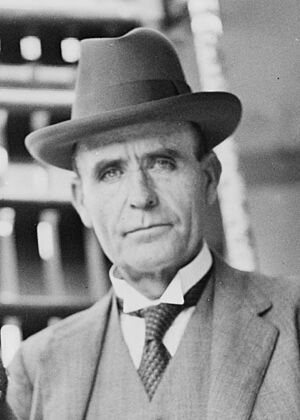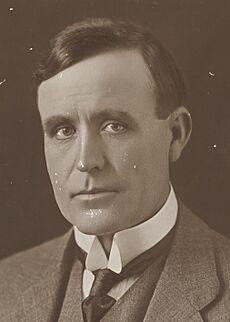William Watt (Australian politician) facts for kids
Quick facts for kids
William Watt
|
|
|---|---|
 |
|
| Speaker of the Australian House of Representatives | |
| In office 28 February 1923 – 12 January 1926 |
|
| Preceded by | Elliot Johnson |
| Succeeded by | Littleton Groom |
| Treasurer of Australia | |
| In office 27 March 1918 – 27 July 1920 |
|
| Prime Minister | Billy Hughes |
| Preceded by | John Forrest |
| Succeeded by | Joseph Cook |
| 24th Premier of Victoria | |
| In office 22 December 1913 – 18 June 1914 |
|
| Preceded by | George Elmslie |
| Succeeded by | Alexander Peacock |
| In office 18 May 1912 – 9 December 1913 |
|
| Preceded by | John Murray |
| Succeeded by | George Elmslie |
| Member of the Australian Parliament for Balaclava |
|
| In office 5 September 1914 – 5 July 1929 |
|
| Preceded by | Agar Wynne |
| Succeeded by | Thomas White |
| Personal details | |
| Born | 23 November 1871 Barfold, Victoria, British Empire |
| Died | 13 September 1946 (aged 74) Toorak, Victoria, Australia |
| Nationality | Australian |
| Political party | Victorian Liberals (to 1914) Commonwealth Liberal (1914–1917) Nationalist Party (from 1917) |
| Spouses |
Florence Carrighan
(m. 1894; died 1896)Emily Seismann
(m. 1907) |
William Alexander Watt (born 23 November 1871, died 13 September 1946) was an important Australian politician. He held several key roles during his career. He was the leader of the state government in Victoria twice, known as the Premier. Later, he moved into national politics.
In the national government, he served as a minister. He even acted as the country's leader, the acting prime minister, during World War I. Finally, he became the Speaker of the Australian Parliament, which is like the referee for debates.
Contents
Early Life and Education
William Watt was born on 23 November 1871 in Barfold, Victoria. This was a small country area near Kyneton. He was the youngest of eleven children. His father was a farmer from Scotland, and his mother was from Ireland.
When William was just one year old, his father passed away. His family then moved to Phillip Island. Six years later, they moved to Melbourne, where he started school. William left school at a young age to work. He was a newsboy and later a clerk.
In 1888, he began studying accountancy at night classes. He became a qualified accountant and later owned a business. William was also active in debating clubs and supported the idea of Australia becoming one nation. He was mentored by a leading politician named Alfred Deakin.
Starting in State Politics
In 1897, William Watt was elected to the Victorian Legislative Assembly. This is the state parliament for Victoria. He represented the area of North Melbourne. He lost his seat in 1900 but was re-elected in 1902 for East Melbourne.
He held different government jobs in Victoria. In 1899, he was the Postmaster-General. From 1909 to 1912, he served as the Treasurer, managing the state's money.
Becoming Premier of Victoria
By 1912, William Watt was a leader in the Liberal Party. He became the Premier of Victoria on 12 May 1912. This meant he was the head of the state government.
In December 1913, his government faced a challenge and he had to step down. For a short time, George Elmslie formed Victoria's first Labor government. But soon after, William Watt became Premier again. He resigned in June 1914, feeling it was hard to get laws passed.
Moving to National Politics
In 1914, William Watt was elected to the Australian House of Representatives. This is part of Australia's national parliament. He won the seat of Balaclava in the federal election.
During World War I, Watt supported Prime Minister Billy Hughes. Hughes wanted to send conscripted troops (people forced to join the army) to fight overseas. This was a big issue that caused a split in the Labor Party. Watt supported Hughes in forming a new government. He became the Minister for Works and Railways.
Acting Prime Minister During Wartime
In March 1918, William Watt became the Treasurer, in charge of the nation's finances. He also became the acting prime minister when Prime Minister Hughes went to London. Watt held this important role until Hughes returned in August 1919.
During this time, he also managed trade and customs. For his service as Acting Prime Minister, he was given the special title "The Right Honourable."
Later Years in Parliament
In April 1920, Prime Minister Hughes sent Watt to London for a financial mission. Watt was not well and felt Hughes was trying to sideline him. He resigned as Treasurer and returned to Australia.
Watt spent the next two years as a regular Member of Parliament. In 1922, he supported other politicians who opposed Prime Minister Hughes. After the elections, Hughes resigned. William Watt was then elected Speaker of the House of Representatives. He held this position until 1926.
The national parliament moved from Melbourne to Canberra in 1927. William Watt found the move demanding. He ran for re-election in 1928 but resigned from parliament nine months later due to health reasons.
After Politics
After leaving parliament, William Watt became the chairman of several companies in Melbourne. These included Barnet Glass and Qantas, which is a well-known airline.
He was also the chairman of trustees for the Melbourne Cricket Ground from 1924 to 1946. This is a famous sports stadium. He also helped start the Victorian branch of the English-Speaking Union.
Family Life
William Watt married Florence Carrighan in 1894. Sadly, she passed away two years later. In 1907, he married Emily Helena Seismann. They had two sons and three daughters.
He had a stroke in 1937, which affected his health. William Watt passed away at his home in Toorak on 13 September 1946, at the age of 74.
Images for kids




